Case Study on Reducing Hospital Readmission in Heart Failure
VerifiedAdded on 2023/06/13
|11
|2586
|306
Case Study
AI Summary
This case study addresses the issue of hospital readmission among heart failure patients, focusing on a 75-year-old man readmitted two years after his initial diagnosis. It reviews three key studies: one examining disease management programs (Gorthi et al., 2014), another on interventions to enhance medication adherence (Molloy et al., 2012), and a third on the effectiveness of nurse-led heart failure clinics (Strömberg et al., 2003). The analysis highlights the importance of tailoring care strategies to individual patient health status, promoting medication adherence through patient education and pharmacist support, and implementing consistent follow-up care by qualified nurses. The study recommends establishing proper disease management programs, frequent nurse-led follow-ups, and patient education to reduce readmission rates, emphasizing the need for hospital leaders to provide adequate resources for these interventions.

1
Addressing Hospital Readmission among Heart Failure Patients
Name:
Institution:
Addressing Hospital Readmission among Heart Failure Patients
Name:
Institution:
Paraphrase This Document
Need a fresh take? Get an instant paraphrase of this document with our AI Paraphraser
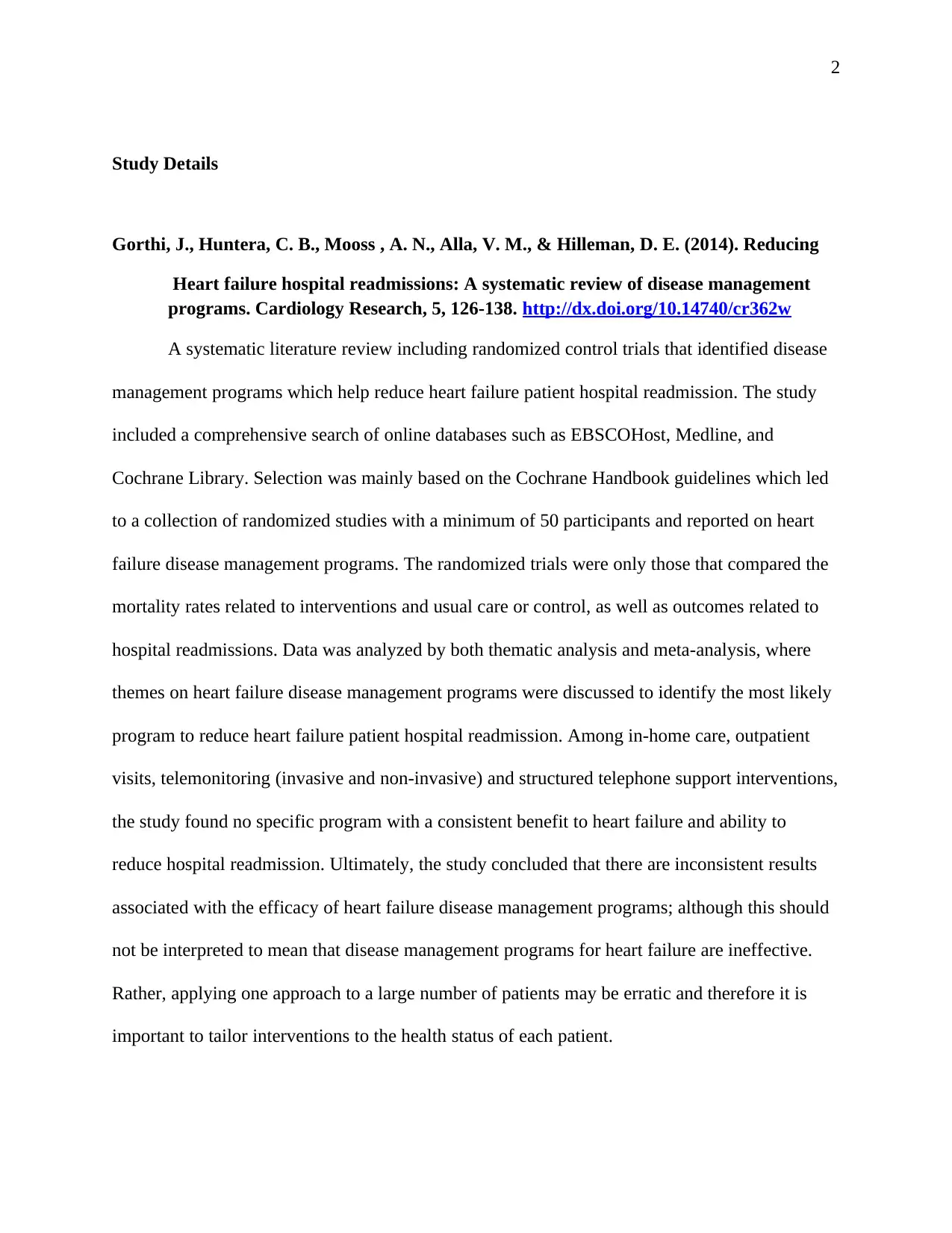
2
Study Details
Gorthi, J., Huntera, C. B., Mooss , A. N., Alla, V. M., & Hilleman, D. E. (2014). Reducing
Heart failure hospital readmissions: A systematic review of disease management
programs. Cardiology Research, 5, 126-138. http://dx.doi.org/10.14740/cr362w
A systematic literature review including randomized control trials that identified disease
management programs which help reduce heart failure patient hospital readmission. The study
included a comprehensive search of online databases such as EBSCOHost, Medline, and
Cochrane Library. Selection was mainly based on the Cochrane Handbook guidelines which led
to a collection of randomized studies with a minimum of 50 participants and reported on heart
failure disease management programs. The randomized trials were only those that compared the
mortality rates related to interventions and usual care or control, as well as outcomes related to
hospital readmissions. Data was analyzed by both thematic analysis and meta-analysis, where
themes on heart failure disease management programs were discussed to identify the most likely
program to reduce heart failure patient hospital readmission. Among in-home care, outpatient
visits, telemonitoring (invasive and non-invasive) and structured telephone support interventions,
the study found no specific program with a consistent benefit to heart failure and ability to
reduce hospital readmission. Ultimately, the study concluded that there are inconsistent results
associated with the efficacy of heart failure disease management programs; although this should
not be interpreted to mean that disease management programs for heart failure are ineffective.
Rather, applying one approach to a large number of patients may be erratic and therefore it is
important to tailor interventions to the health status of each patient.
Study Details
Gorthi, J., Huntera, C. B., Mooss , A. N., Alla, V. M., & Hilleman, D. E. (2014). Reducing
Heart failure hospital readmissions: A systematic review of disease management
programs. Cardiology Research, 5, 126-138. http://dx.doi.org/10.14740/cr362w
A systematic literature review including randomized control trials that identified disease
management programs which help reduce heart failure patient hospital readmission. The study
included a comprehensive search of online databases such as EBSCOHost, Medline, and
Cochrane Library. Selection was mainly based on the Cochrane Handbook guidelines which led
to a collection of randomized studies with a minimum of 50 participants and reported on heart
failure disease management programs. The randomized trials were only those that compared the
mortality rates related to interventions and usual care or control, as well as outcomes related to
hospital readmissions. Data was analyzed by both thematic analysis and meta-analysis, where
themes on heart failure disease management programs were discussed to identify the most likely
program to reduce heart failure patient hospital readmission. Among in-home care, outpatient
visits, telemonitoring (invasive and non-invasive) and structured telephone support interventions,
the study found no specific program with a consistent benefit to heart failure and ability to
reduce hospital readmission. Ultimately, the study concluded that there are inconsistent results
associated with the efficacy of heart failure disease management programs; although this should
not be interpreted to mean that disease management programs for heart failure are ineffective.
Rather, applying one approach to a large number of patients may be erratic and therefore it is
important to tailor interventions to the health status of each patient.
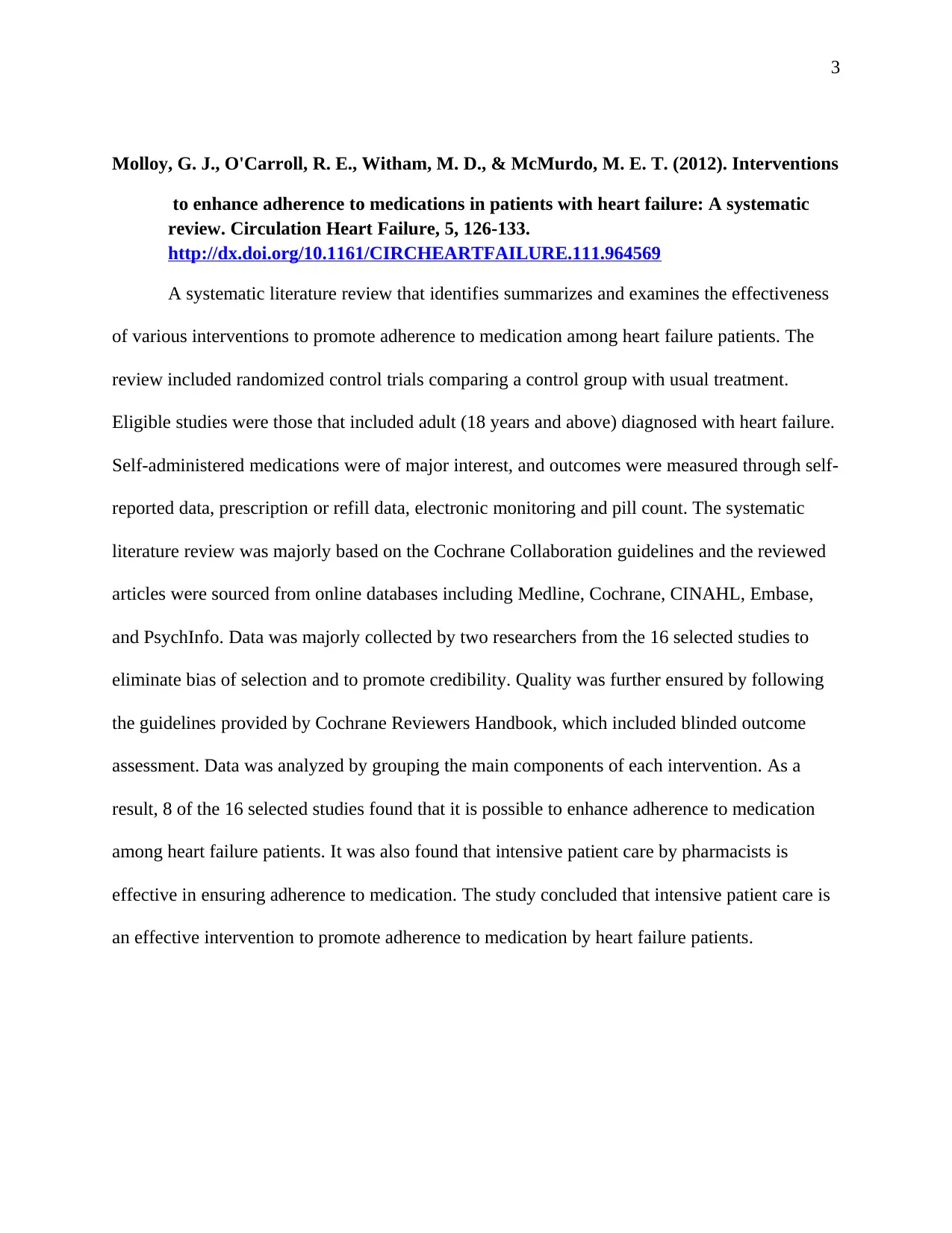
3
Molloy, G. J., O'Carroll, R. E., Witham, M. D., & McMurdo, M. E. T. (2012). Interventions
to enhance adherence to medications in patients with heart failure: A systematic
review. Circulation Heart Failure, 5, 126-133.
http://dx.doi.org/10.1161/CIRCHEARTFAILURE.111.964569
A systematic literature review that identifies summarizes and examines the effectiveness
of various interventions to promote adherence to medication among heart failure patients. The
review included randomized control trials comparing a control group with usual treatment.
Eligible studies were those that included adult (18 years and above) diagnosed with heart failure.
Self-administered medications were of major interest, and outcomes were measured through self-
reported data, prescription or refill data, electronic monitoring and pill count. The systematic
literature review was majorly based on the Cochrane Collaboration guidelines and the reviewed
articles were sourced from online databases including Medline, Cochrane, CINAHL, Embase,
and PsychInfo. Data was majorly collected by two researchers from the 16 selected studies to
eliminate bias of selection and to promote credibility. Quality was further ensured by following
the guidelines provided by Cochrane Reviewers Handbook, which included blinded outcome
assessment. Data was analyzed by grouping the main components of each intervention. As a
result, 8 of the 16 selected studies found that it is possible to enhance adherence to medication
among heart failure patients. It was also found that intensive patient care by pharmacists is
effective in ensuring adherence to medication. The study concluded that intensive patient care is
an effective intervention to promote adherence to medication by heart failure patients.
Molloy, G. J., O'Carroll, R. E., Witham, M. D., & McMurdo, M. E. T. (2012). Interventions
to enhance adherence to medications in patients with heart failure: A systematic
review. Circulation Heart Failure, 5, 126-133.
http://dx.doi.org/10.1161/CIRCHEARTFAILURE.111.964569
A systematic literature review that identifies summarizes and examines the effectiveness
of various interventions to promote adherence to medication among heart failure patients. The
review included randomized control trials comparing a control group with usual treatment.
Eligible studies were those that included adult (18 years and above) diagnosed with heart failure.
Self-administered medications were of major interest, and outcomes were measured through self-
reported data, prescription or refill data, electronic monitoring and pill count. The systematic
literature review was majorly based on the Cochrane Collaboration guidelines and the reviewed
articles were sourced from online databases including Medline, Cochrane, CINAHL, Embase,
and PsychInfo. Data was majorly collected by two researchers from the 16 selected studies to
eliminate bias of selection and to promote credibility. Quality was further ensured by following
the guidelines provided by Cochrane Reviewers Handbook, which included blinded outcome
assessment. Data was analyzed by grouping the main components of each intervention. As a
result, 8 of the 16 selected studies found that it is possible to enhance adherence to medication
among heart failure patients. It was also found that intensive patient care by pharmacists is
effective in ensuring adherence to medication. The study concluded that intensive patient care is
an effective intervention to promote adherence to medication by heart failure patients.
⊘ This is a preview!⊘
Do you want full access?
Subscribe today to unlock all pages.

Trusted by 1+ million students worldwide
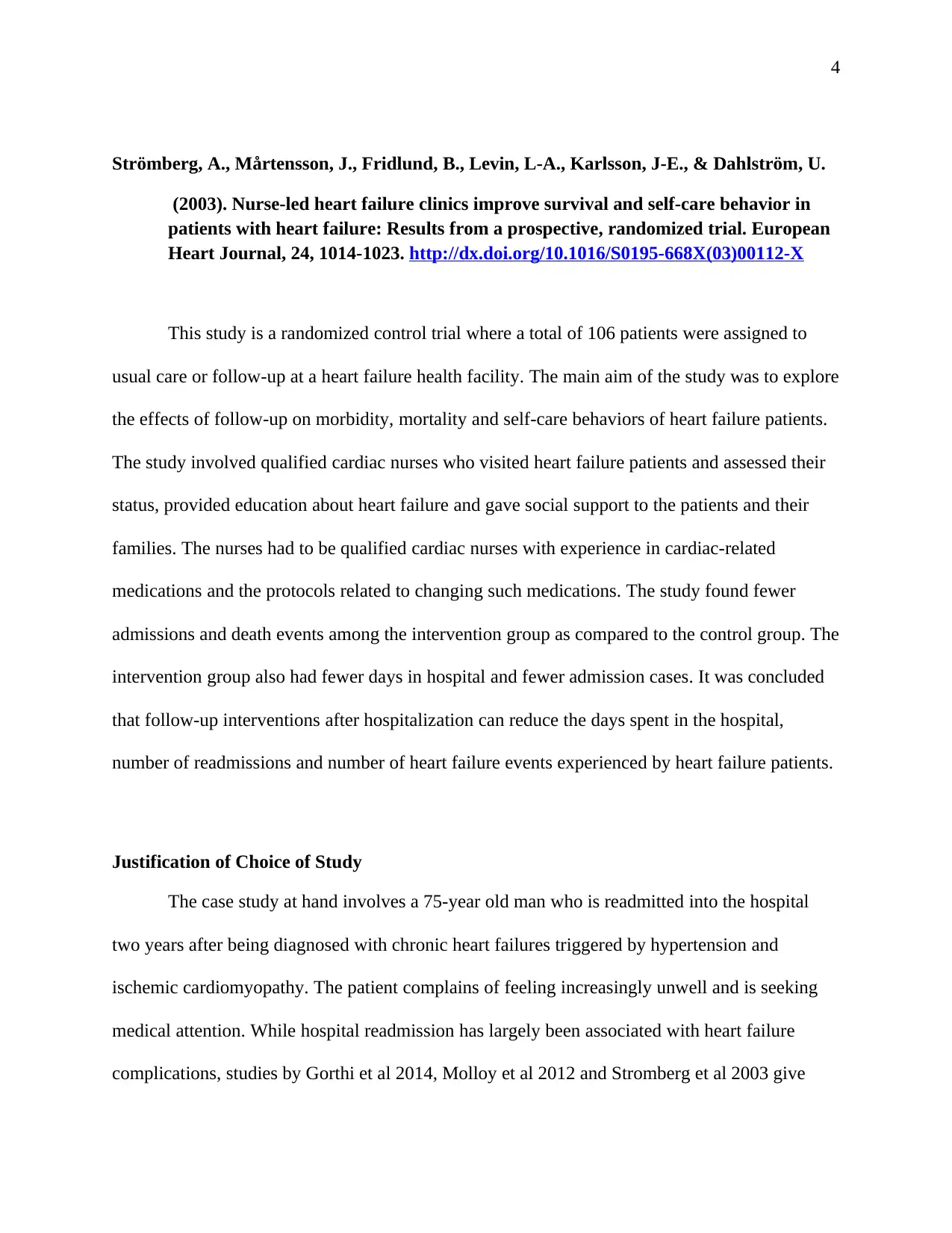
4
Strömberg, A., Mårtensson, J., Fridlund, B., Levin, L-A., Karlsson, J-E., & Dahlström, U.
(2003). Nurse-led heart failure clinics improve survival and self-care behavior in
patients with heart failure: Results from a prospective, randomized trial. European
Heart Journal, 24, 1014-1023. http://dx.doi.org/10.1016/S0195-668X(03)00112-X
This study is a randomized control trial where a total of 106 patients were assigned to
usual care or follow-up at a heart failure health facility. The main aim of the study was to explore
the effects of follow-up on morbidity, mortality and self-care behaviors of heart failure patients.
The study involved qualified cardiac nurses who visited heart failure patients and assessed their
status, provided education about heart failure and gave social support to the patients and their
families. The nurses had to be qualified cardiac nurses with experience in cardiac-related
medications and the protocols related to changing such medications. The study found fewer
admissions and death events among the intervention group as compared to the control group. The
intervention group also had fewer days in hospital and fewer admission cases. It was concluded
that follow-up interventions after hospitalization can reduce the days spent in the hospital,
number of readmissions and number of heart failure events experienced by heart failure patients.
Justification of Choice of Study
The case study at hand involves a 75-year old man who is readmitted into the hospital
two years after being diagnosed with chronic heart failures triggered by hypertension and
ischemic cardiomyopathy. The patient complains of feeling increasingly unwell and is seeking
medical attention. While hospital readmission has largely been associated with heart failure
complications, studies by Gorthi et al 2014, Molloy et al 2012 and Stromberg et al 2003 give
Strömberg, A., Mårtensson, J., Fridlund, B., Levin, L-A., Karlsson, J-E., & Dahlström, U.
(2003). Nurse-led heart failure clinics improve survival and self-care behavior in
patients with heart failure: Results from a prospective, randomized trial. European
Heart Journal, 24, 1014-1023. http://dx.doi.org/10.1016/S0195-668X(03)00112-X
This study is a randomized control trial where a total of 106 patients were assigned to
usual care or follow-up at a heart failure health facility. The main aim of the study was to explore
the effects of follow-up on morbidity, mortality and self-care behaviors of heart failure patients.
The study involved qualified cardiac nurses who visited heart failure patients and assessed their
status, provided education about heart failure and gave social support to the patients and their
families. The nurses had to be qualified cardiac nurses with experience in cardiac-related
medications and the protocols related to changing such medications. The study found fewer
admissions and death events among the intervention group as compared to the control group. The
intervention group also had fewer days in hospital and fewer admission cases. It was concluded
that follow-up interventions after hospitalization can reduce the days spent in the hospital,
number of readmissions and number of heart failure events experienced by heart failure patients.
Justification of Choice of Study
The case study at hand involves a 75-year old man who is readmitted into the hospital
two years after being diagnosed with chronic heart failures triggered by hypertension and
ischemic cardiomyopathy. The patient complains of feeling increasingly unwell and is seeking
medical attention. While hospital readmission has largely been associated with heart failure
complications, studies by Gorthi et al 2014, Molloy et al 2012 and Stromberg et al 2003 give
Paraphrase This Document
Need a fresh take? Get an instant paraphrase of this document with our AI Paraphraser

5
incredible insights into the management heart failure and prevention of hospital readmission. The
following section will justify the relevance and importance of these studies to the case study.
Gorthi et al 2014
Against this backdrop, Gorthi et al initiated a systematic literature review to explore
various disease management programs that can be implemented to reduce cases of heart failure
hospital readmission. The findings of this study give important details that can assist in
delivering proper care to Charlie. For instance, the study suggested that patients should be
subjected to care strategies that are unique to their prevailing health status to improve the
effectiveness of such interventions and reduce hospital readmission. These findings are similar to
assertions by Vecchione (2017) and Thompson et al (2016) that interventions such as home visits
and telemonitoring are effective ways of managing heart failure complication at low costs
although caution must be taken to choose the right intervention that responds to the patient’s
conditions. While the study may have been subject to various limitations, it displays reliable
quality based on the methodology applied. For example, the study relied on strict inclusion and
exclusion criteria which saw it select journals written in English language and only those that
included a minimum of 50 participants. Similarly, the study relied on the Cochrane Handbook
guidelines. According to Salerno (2017), these guidelines are known for establishing a higher
threshold of quality that studies have to attain to be considered valid and reliable.
incredible insights into the management heart failure and prevention of hospital readmission. The
following section will justify the relevance and importance of these studies to the case study.
Gorthi et al 2014
Against this backdrop, Gorthi et al initiated a systematic literature review to explore
various disease management programs that can be implemented to reduce cases of heart failure
hospital readmission. The findings of this study give important details that can assist in
delivering proper care to Charlie. For instance, the study suggested that patients should be
subjected to care strategies that are unique to their prevailing health status to improve the
effectiveness of such interventions and reduce hospital readmission. These findings are similar to
assertions by Vecchione (2017) and Thompson et al (2016) that interventions such as home visits
and telemonitoring are effective ways of managing heart failure complication at low costs
although caution must be taken to choose the right intervention that responds to the patient’s
conditions. While the study may have been subject to various limitations, it displays reliable
quality based on the methodology applied. For example, the study relied on strict inclusion and
exclusion criteria which saw it select journals written in English language and only those that
included a minimum of 50 participants. Similarly, the study relied on the Cochrane Handbook
guidelines. According to Salerno (2017), these guidelines are known for establishing a higher
threshold of quality that studies have to attain to be considered valid and reliable.
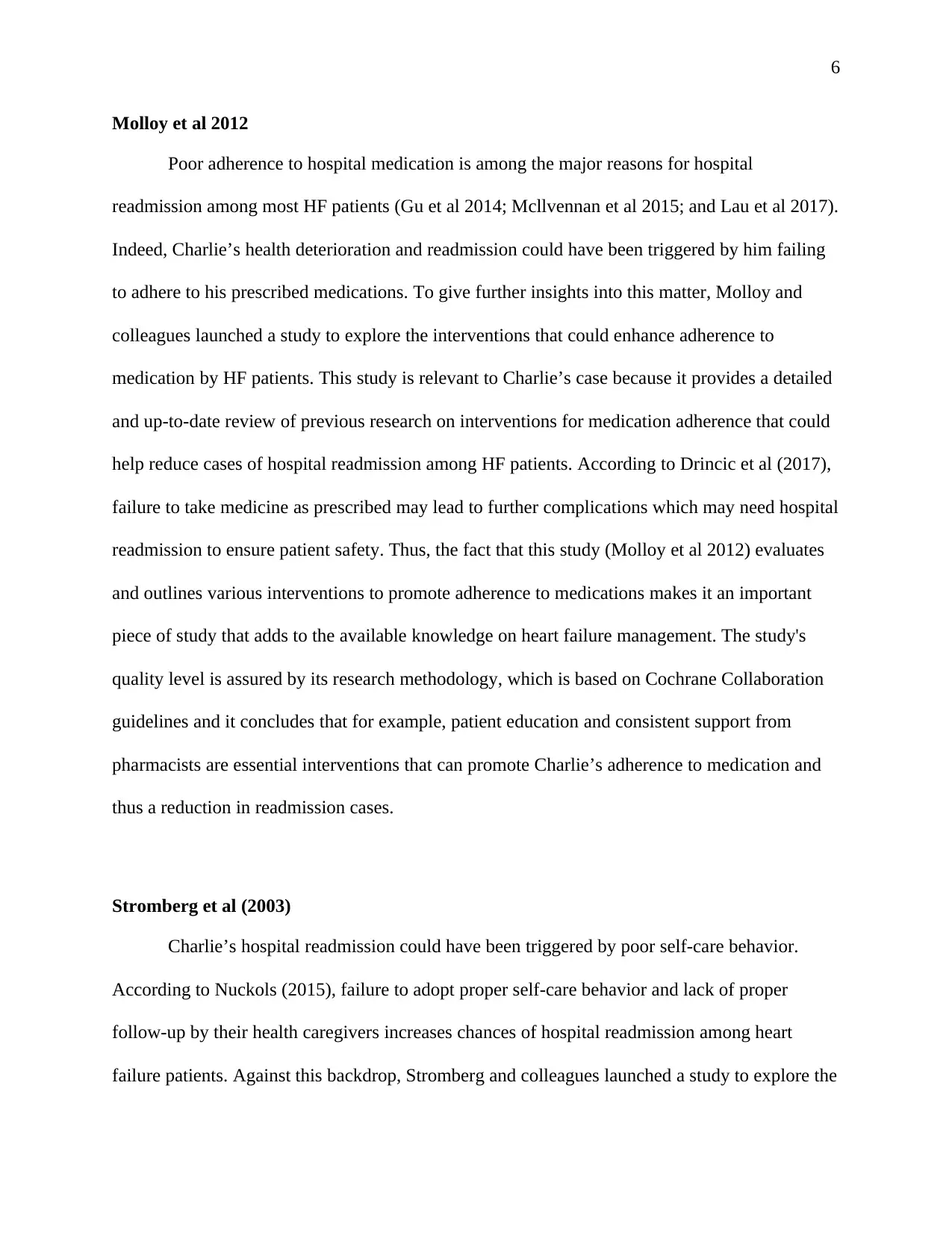
6
Molloy et al 2012
Poor adherence to hospital medication is among the major reasons for hospital
readmission among most HF patients (Gu et al 2014; Mcllvennan et al 2015; and Lau et al 2017).
Indeed, Charlie’s health deterioration and readmission could have been triggered by him failing
to adhere to his prescribed medications. To give further insights into this matter, Molloy and
colleagues launched a study to explore the interventions that could enhance adherence to
medication by HF patients. This study is relevant to Charlie’s case because it provides a detailed
and up-to-date review of previous research on interventions for medication adherence that could
help reduce cases of hospital readmission among HF patients. According to Drincic et al (2017),
failure to take medicine as prescribed may lead to further complications which may need hospital
readmission to ensure patient safety. Thus, the fact that this study (Molloy et al 2012) evaluates
and outlines various interventions to promote adherence to medications makes it an important
piece of study that adds to the available knowledge on heart failure management. The study's
quality level is assured by its research methodology, which is based on Cochrane Collaboration
guidelines and it concludes that for example, patient education and consistent support from
pharmacists are essential interventions that can promote Charlie’s adherence to medication and
thus a reduction in readmission cases.
Stromberg et al (2003)
Charlie’s hospital readmission could have been triggered by poor self-care behavior.
According to Nuckols (2015), failure to adopt proper self-care behavior and lack of proper
follow-up by their health caregivers increases chances of hospital readmission among heart
failure patients. Against this backdrop, Stromberg and colleagues launched a study to explore the
Molloy et al 2012
Poor adherence to hospital medication is among the major reasons for hospital
readmission among most HF patients (Gu et al 2014; Mcllvennan et al 2015; and Lau et al 2017).
Indeed, Charlie’s health deterioration and readmission could have been triggered by him failing
to adhere to his prescribed medications. To give further insights into this matter, Molloy and
colleagues launched a study to explore the interventions that could enhance adherence to
medication by HF patients. This study is relevant to Charlie’s case because it provides a detailed
and up-to-date review of previous research on interventions for medication adherence that could
help reduce cases of hospital readmission among HF patients. According to Drincic et al (2017),
failure to take medicine as prescribed may lead to further complications which may need hospital
readmission to ensure patient safety. Thus, the fact that this study (Molloy et al 2012) evaluates
and outlines various interventions to promote adherence to medications makes it an important
piece of study that adds to the available knowledge on heart failure management. The study's
quality level is assured by its research methodology, which is based on Cochrane Collaboration
guidelines and it concludes that for example, patient education and consistent support from
pharmacists are essential interventions that can promote Charlie’s adherence to medication and
thus a reduction in readmission cases.
Stromberg et al (2003)
Charlie’s hospital readmission could have been triggered by poor self-care behavior.
According to Nuckols (2015), failure to adopt proper self-care behavior and lack of proper
follow-up by their health caregivers increases chances of hospital readmission among heart
failure patients. Against this backdrop, Stromberg and colleagues launched a study to explore the
⊘ This is a preview!⊘
Do you want full access?
Subscribe today to unlock all pages.

Trusted by 1+ million students worldwide
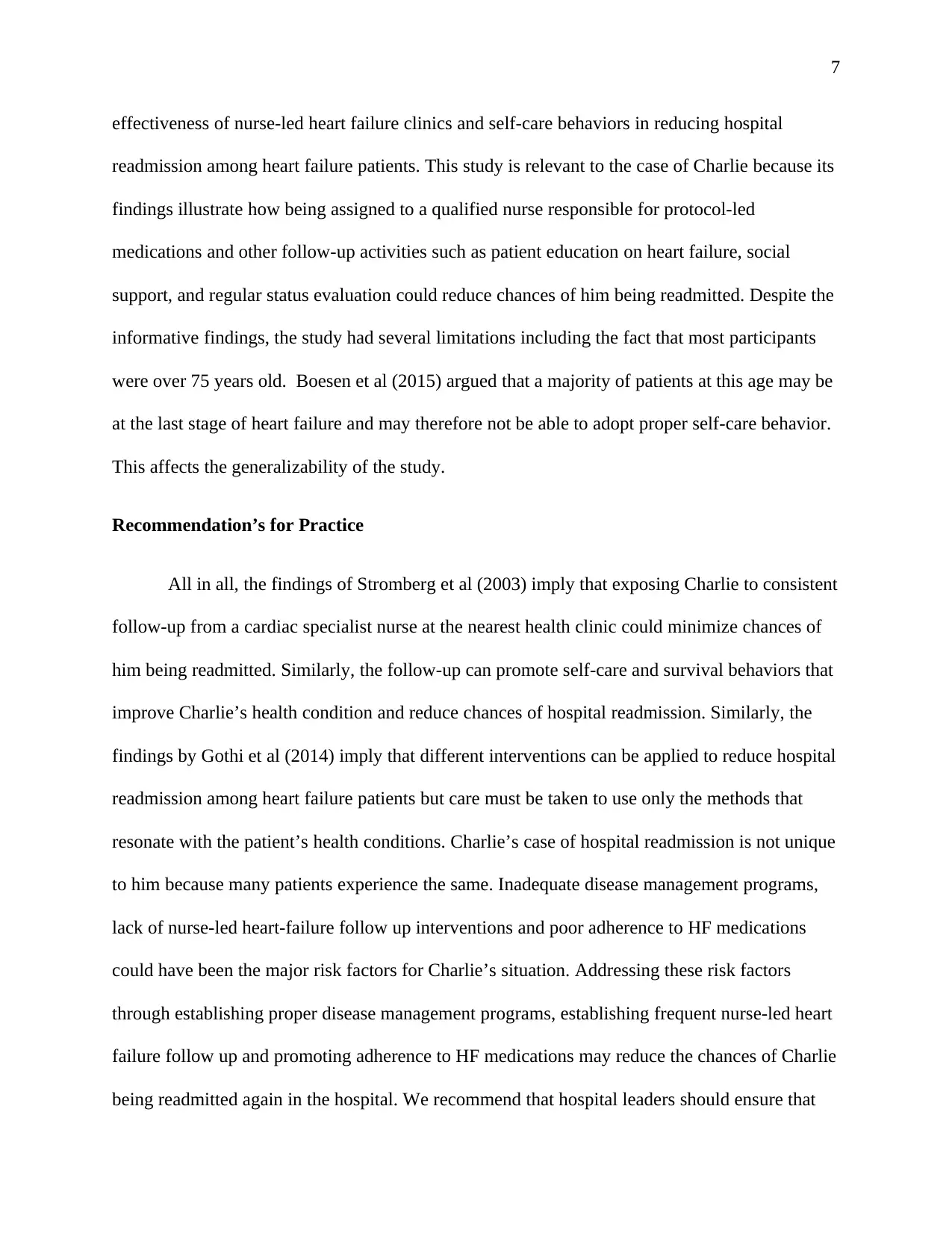
7
effectiveness of nurse-led heart failure clinics and self-care behaviors in reducing hospital
readmission among heart failure patients. This study is relevant to the case of Charlie because its
findings illustrate how being assigned to a qualified nurse responsible for protocol-led
medications and other follow-up activities such as patient education on heart failure, social
support, and regular status evaluation could reduce chances of him being readmitted. Despite the
informative findings, the study had several limitations including the fact that most participants
were over 75 years old. Boesen et al (2015) argued that a majority of patients at this age may be
at the last stage of heart failure and may therefore not be able to adopt proper self-care behavior.
This affects the generalizability of the study.
Recommendation’s for Practice
All in all, the findings of Stromberg et al (2003) imply that exposing Charlie to consistent
follow-up from a cardiac specialist nurse at the nearest health clinic could minimize chances of
him being readmitted. Similarly, the follow-up can promote self-care and survival behaviors that
improve Charlie’s health condition and reduce chances of hospital readmission. Similarly, the
findings by Gothi et al (2014) imply that different interventions can be applied to reduce hospital
readmission among heart failure patients but care must be taken to use only the methods that
resonate with the patient’s health conditions. Charlie’s case of hospital readmission is not unique
to him because many patients experience the same. Inadequate disease management programs,
lack of nurse-led heart-failure follow up interventions and poor adherence to HF medications
could have been the major risk factors for Charlie’s situation. Addressing these risk factors
through establishing proper disease management programs, establishing frequent nurse-led heart
failure follow up and promoting adherence to HF medications may reduce the chances of Charlie
being readmitted again in the hospital. We recommend that hospital leaders should ensure that
effectiveness of nurse-led heart failure clinics and self-care behaviors in reducing hospital
readmission among heart failure patients. This study is relevant to the case of Charlie because its
findings illustrate how being assigned to a qualified nurse responsible for protocol-led
medications and other follow-up activities such as patient education on heart failure, social
support, and regular status evaluation could reduce chances of him being readmitted. Despite the
informative findings, the study had several limitations including the fact that most participants
were over 75 years old. Boesen et al (2015) argued that a majority of patients at this age may be
at the last stage of heart failure and may therefore not be able to adopt proper self-care behavior.
This affects the generalizability of the study.
Recommendation’s for Practice
All in all, the findings of Stromberg et al (2003) imply that exposing Charlie to consistent
follow-up from a cardiac specialist nurse at the nearest health clinic could minimize chances of
him being readmitted. Similarly, the follow-up can promote self-care and survival behaviors that
improve Charlie’s health condition and reduce chances of hospital readmission. Similarly, the
findings by Gothi et al (2014) imply that different interventions can be applied to reduce hospital
readmission among heart failure patients but care must be taken to use only the methods that
resonate with the patient’s health conditions. Charlie’s case of hospital readmission is not unique
to him because many patients experience the same. Inadequate disease management programs,
lack of nurse-led heart-failure follow up interventions and poor adherence to HF medications
could have been the major risk factors for Charlie’s situation. Addressing these risk factors
through establishing proper disease management programs, establishing frequent nurse-led heart
failure follow up and promoting adherence to HF medications may reduce the chances of Charlie
being readmitted again in the hospital. We recommend that hospital leaders should ensure that
Paraphrase This Document
Need a fresh take? Get an instant paraphrase of this document with our AI Paraphraser
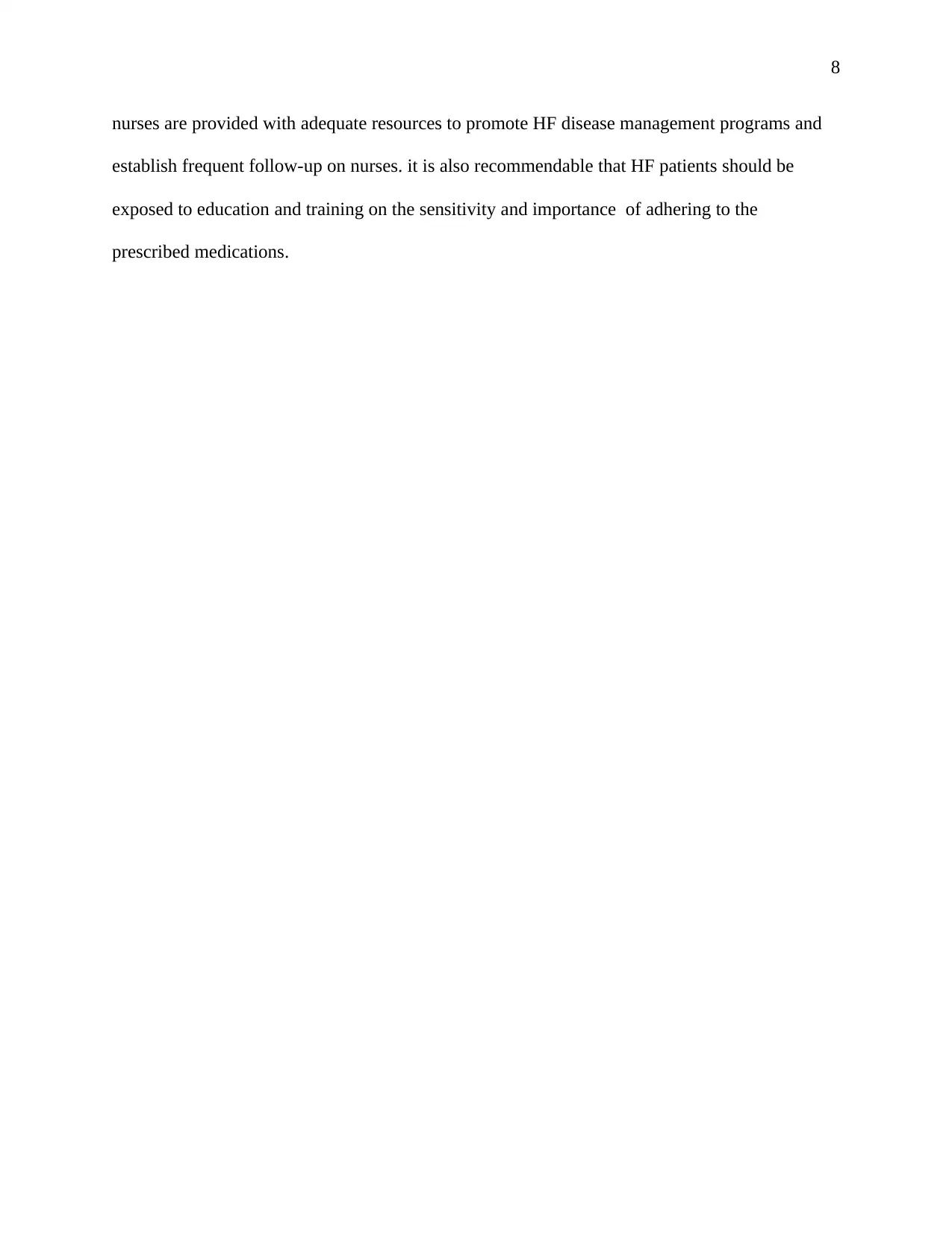
8
nurses are provided with adequate resources to promote HF disease management programs and
establish frequent follow-up on nurses. it is also recommendable that HF patients should be
exposed to education and training on the sensitivity and importance of adhering to the
prescribed medications.
nurses are provided with adequate resources to promote HF disease management programs and
establish frequent follow-up on nurses. it is also recommendable that HF patients should be
exposed to education and training on the sensitivity and importance of adhering to the
prescribed medications.
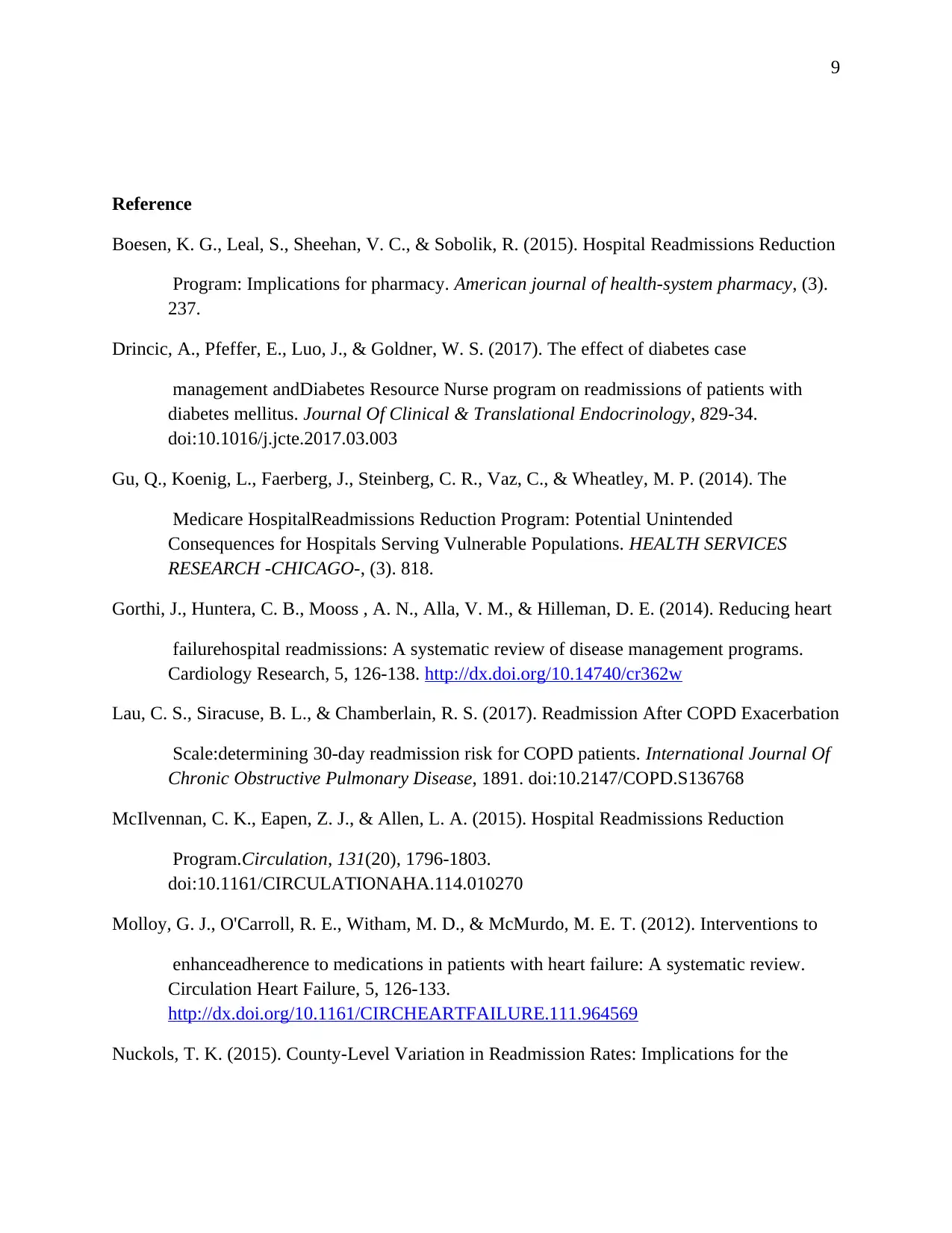
9
Reference
Boesen, K. G., Leal, S., Sheehan, V. C., & Sobolik, R. (2015). Hospital Readmissions Reduction
Program: Implications for pharmacy. American journal of health-system pharmacy, (3).
237.
Drincic, A., Pfeffer, E., Luo, J., & Goldner, W. S. (2017). The effect of diabetes case
management andDiabetes Resource Nurse program on readmissions of patients with
diabetes mellitus. Journal Of Clinical & Translational Endocrinology, 829-34.
doi:10.1016/j.jcte.2017.03.003
Gu, Q., Koenig, L., Faerberg, J., Steinberg, C. R., Vaz, C., & Wheatley, M. P. (2014). The
Medicare HospitalReadmissions Reduction Program: Potential Unintended
Consequences for Hospitals Serving Vulnerable Populations. HEALTH SERVICES
RESEARCH -CHICAGO-, (3). 818.
Gorthi, J., Huntera, C. B., Mooss , A. N., Alla, V. M., & Hilleman, D. E. (2014). Reducing heart
failurehospital readmissions: A systematic review of disease management programs.
Cardiology Research, 5, 126-138. http://dx.doi.org/10.14740/cr362w
Lau, C. S., Siracuse, B. L., & Chamberlain, R. S. (2017). Readmission After COPD Exacerbation
Scale:determining 30-day readmission risk for COPD patients. International Journal Of
Chronic Obstructive Pulmonary Disease, 1891. doi:10.2147/COPD.S136768
McIlvennan, C. K., Eapen, Z. J., & Allen, L. A. (2015). Hospital Readmissions Reduction
Program.Circulation, 131(20), 1796-1803.
doi:10.1161/CIRCULATIONAHA.114.010270
Molloy, G. J., O'Carroll, R. E., Witham, M. D., & McMurdo, M. E. T. (2012). Interventions to
enhanceadherence to medications in patients with heart failure: A systematic review.
Circulation Heart Failure, 5, 126-133.
http://dx.doi.org/10.1161/CIRCHEARTFAILURE.111.964569
Nuckols, T. K. (2015). County-Level Variation in Readmission Rates: Implications for the
Reference
Boesen, K. G., Leal, S., Sheehan, V. C., & Sobolik, R. (2015). Hospital Readmissions Reduction
Program: Implications for pharmacy. American journal of health-system pharmacy, (3).
237.
Drincic, A., Pfeffer, E., Luo, J., & Goldner, W. S. (2017). The effect of diabetes case
management andDiabetes Resource Nurse program on readmissions of patients with
diabetes mellitus. Journal Of Clinical & Translational Endocrinology, 829-34.
doi:10.1016/j.jcte.2017.03.003
Gu, Q., Koenig, L., Faerberg, J., Steinberg, C. R., Vaz, C., & Wheatley, M. P. (2014). The
Medicare HospitalReadmissions Reduction Program: Potential Unintended
Consequences for Hospitals Serving Vulnerable Populations. HEALTH SERVICES
RESEARCH -CHICAGO-, (3). 818.
Gorthi, J., Huntera, C. B., Mooss , A. N., Alla, V. M., & Hilleman, D. E. (2014). Reducing heart
failurehospital readmissions: A systematic review of disease management programs.
Cardiology Research, 5, 126-138. http://dx.doi.org/10.14740/cr362w
Lau, C. S., Siracuse, B. L., & Chamberlain, R. S. (2017). Readmission After COPD Exacerbation
Scale:determining 30-day readmission risk for COPD patients. International Journal Of
Chronic Obstructive Pulmonary Disease, 1891. doi:10.2147/COPD.S136768
McIlvennan, C. K., Eapen, Z. J., & Allen, L. A. (2015). Hospital Readmissions Reduction
Program.Circulation, 131(20), 1796-1803.
doi:10.1161/CIRCULATIONAHA.114.010270
Molloy, G. J., O'Carroll, R. E., Witham, M. D., & McMurdo, M. E. T. (2012). Interventions to
enhanceadherence to medications in patients with heart failure: A systematic review.
Circulation Heart Failure, 5, 126-133.
http://dx.doi.org/10.1161/CIRCHEARTFAILURE.111.964569
Nuckols, T. K. (2015). County-Level Variation in Readmission Rates: Implications for the
⊘ This is a preview!⊘
Do you want full access?
Subscribe today to unlock all pages.

Trusted by 1+ million students worldwide
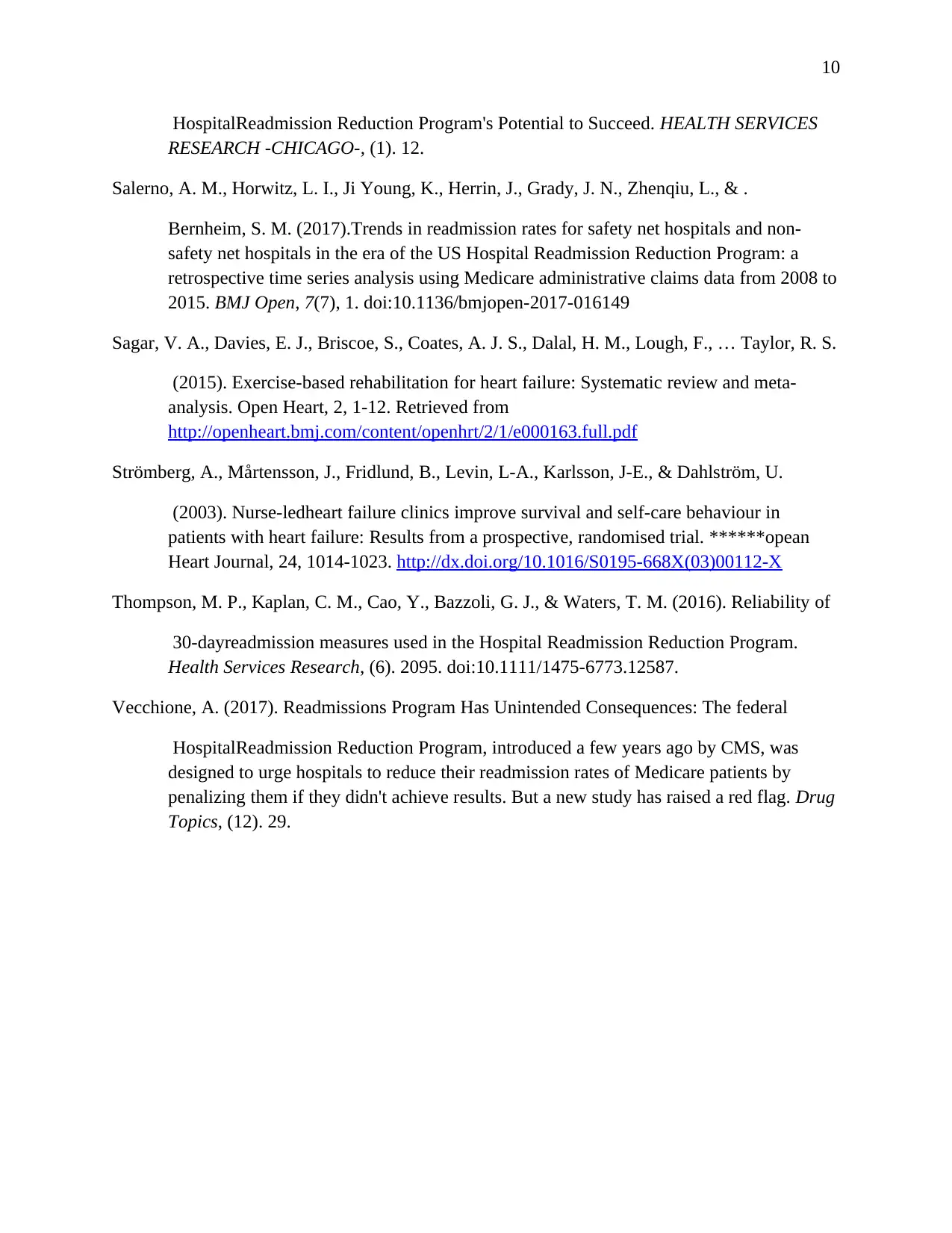
10
HospitalReadmission Reduction Program's Potential to Succeed. HEALTH SERVICES
RESEARCH -CHICAGO-, (1). 12.
Salerno, A. M., Horwitz, L. I., Ji Young, K., Herrin, J., Grady, J. N., Zhenqiu, L., & .
Bernheim, S. M. (2017).Trends in readmission rates for safety net hospitals and non-
safety net hospitals in the era of the US Hospital Readmission Reduction Program: a
retrospective time series analysis using Medicare administrative claims data from 2008 to
2015. BMJ Open, 7(7), 1. doi:10.1136/bmjopen-2017-016149
Sagar, V. A., Davies, E. J., Briscoe, S., Coates, A. J. S., Dalal, H. M., Lough, F., … Taylor, R. S.
(2015). Exercise-based rehabilitation for heart failure: Systematic review and meta-
analysis. Open Heart, 2, 1-12. Retrieved from
http://openheart.bmj.com/content/openhrt/2/1/e000163.full.pdf
Strömberg, A., Mårtensson, J., Fridlund, B., Levin, L-A., Karlsson, J-E., & Dahlström, U.
(2003). Nurse-ledheart failure clinics improve survival and self-care behaviour in
patients with heart failure: Results from a prospective, randomised trial. ******opean
Heart Journal, 24, 1014-1023. http://dx.doi.org/10.1016/S0195-668X(03)00112-X
Thompson, M. P., Kaplan, C. M., Cao, Y., Bazzoli, G. J., & Waters, T. M. (2016). Reliability of
30-dayreadmission measures used in the Hospital Readmission Reduction Program.
Health Services Research, (6). 2095. doi:10.1111/1475-6773.12587.
Vecchione, A. (2017). Readmissions Program Has Unintended Consequences: The federal
HospitalReadmission Reduction Program, introduced a few years ago by CMS, was
designed to urge hospitals to reduce their readmission rates of Medicare patients by
penalizing them if they didn't achieve results. But a new study has raised a red flag. Drug
Topics, (12). 29.
HospitalReadmission Reduction Program's Potential to Succeed. HEALTH SERVICES
RESEARCH -CHICAGO-, (1). 12.
Salerno, A. M., Horwitz, L. I., Ji Young, K., Herrin, J., Grady, J. N., Zhenqiu, L., & .
Bernheim, S. M. (2017).Trends in readmission rates for safety net hospitals and non-
safety net hospitals in the era of the US Hospital Readmission Reduction Program: a
retrospective time series analysis using Medicare administrative claims data from 2008 to
2015. BMJ Open, 7(7), 1. doi:10.1136/bmjopen-2017-016149
Sagar, V. A., Davies, E. J., Briscoe, S., Coates, A. J. S., Dalal, H. M., Lough, F., … Taylor, R. S.
(2015). Exercise-based rehabilitation for heart failure: Systematic review and meta-
analysis. Open Heart, 2, 1-12. Retrieved from
http://openheart.bmj.com/content/openhrt/2/1/e000163.full.pdf
Strömberg, A., Mårtensson, J., Fridlund, B., Levin, L-A., Karlsson, J-E., & Dahlström, U.
(2003). Nurse-ledheart failure clinics improve survival and self-care behaviour in
patients with heart failure: Results from a prospective, randomised trial. ******opean
Heart Journal, 24, 1014-1023. http://dx.doi.org/10.1016/S0195-668X(03)00112-X
Thompson, M. P., Kaplan, C. M., Cao, Y., Bazzoli, G. J., & Waters, T. M. (2016). Reliability of
30-dayreadmission measures used in the Hospital Readmission Reduction Program.
Health Services Research, (6). 2095. doi:10.1111/1475-6773.12587.
Vecchione, A. (2017). Readmissions Program Has Unintended Consequences: The federal
HospitalReadmission Reduction Program, introduced a few years ago by CMS, was
designed to urge hospitals to reduce their readmission rates of Medicare patients by
penalizing them if they didn't achieve results. But a new study has raised a red flag. Drug
Topics, (12). 29.
Paraphrase This Document
Need a fresh take? Get an instant paraphrase of this document with our AI Paraphraser

11
1 out of 11
Related Documents
Your All-in-One AI-Powered Toolkit for Academic Success.
+13062052269
info@desklib.com
Available 24*7 on WhatsApp / Email
![[object Object]](/_next/static/media/star-bottom.7253800d.svg)
Unlock your academic potential
Copyright © 2020–2025 A2Z Services. All Rights Reserved. Developed and managed by ZUCOL.





